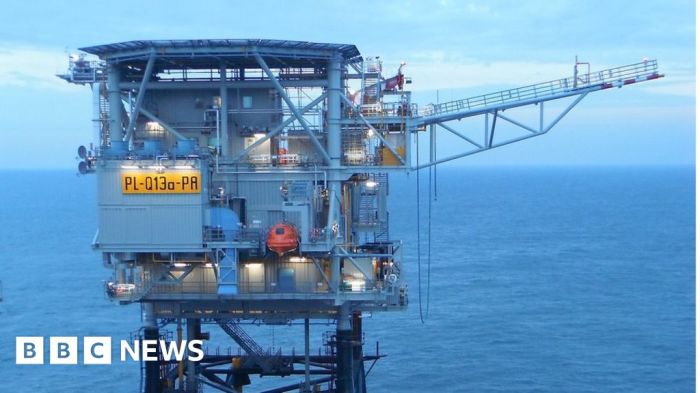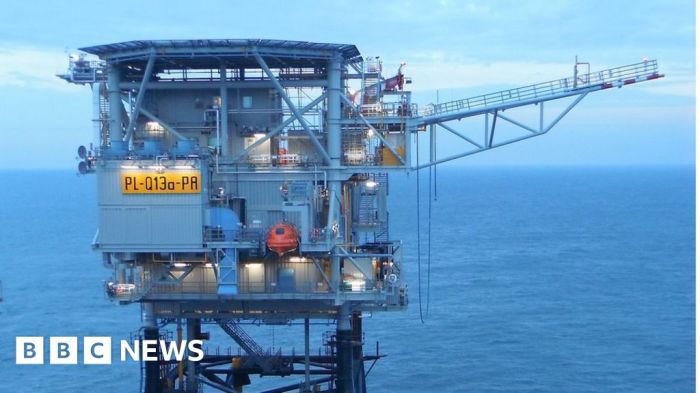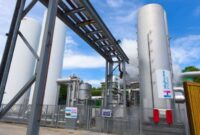Offshore wind to hydrogen europe clean energy demand – Offshore wind to hydrogen: Europe’s clean energy demand is soaring, and offshore wind is a key player in meeting this demand. But what if we could go beyond simply generating electricity and use this renewable power to produce hydrogen, a versatile energy carrier with vast potential?
This is precisely the vision driving the emerging field of offshore wind-to-hydrogen, which promises to revolutionize Europe’s energy landscape.
This innovative approach harnesses the power of offshore wind turbines to split water molecules through electrolysis, producing clean hydrogen. This hydrogen can then be used to fuel transportation, heat homes, and power industries, creating a truly sustainable energy system. The potential is immense, with Europe’s vast offshore wind resources and growing hydrogen demand setting the stage for a green energy revolution.
Offshore Wind Energy Potential in Europe: Offshore Wind To Hydrogen Europe Clean Energy Demand
Europe is at the forefront of the global transition to renewable energy, and offshore wind plays a crucial role in this endeavor. The continent boasts vast offshore wind resources, making it a prime location for harnessing this clean and sustainable energy source.
Current and Projected Capacity of Offshore Wind Farms in Europe
The European offshore wind industry has experienced significant growth in recent years. As of 2022, the total installed capacity of offshore wind farms in Europe reached approximately 26 gigawatts (GW). This represents a substantial increase from just a few years ago, highlighting the rapid development of this sector.
The European Union (EU) has set ambitious targets for offshore wind deployment, aiming to reach 150 GW of installed capacity by 2050. This target reflects the EU’s commitment to decarbonizing its energy sector and achieving climate neutrality.
Geographic Distribution of Offshore Wind Resources Across European Countries
Offshore wind resources are distributed unevenly across Europe. The North Sea region, particularly the waters surrounding the United Kingdom, Germany, Denmark, and the Netherlands, possesses the most significant potential for offshore wind development. These countries have already established substantial offshore wind industries, with numerous projects in operation or under construction.
Other regions, such as the Baltic Sea, the Mediterranean Sea, and the Atlantic Ocean, also hold promising offshore wind resources, though their development is at an earlier stage.
Cost Competitiveness of Offshore Wind Energy
Offshore wind energy has become increasingly cost-competitive with traditional fossil fuels in recent years. The cost of offshore wind technology has declined significantly due to advancements in turbine design, installation techniques, and economies of scale. In some regions, offshore wind energy is now cheaper than coal and gas-fired power generation.
This cost competitiveness makes offshore wind an attractive option for electricity producers and consumers alike.
Hydrogen Production from Offshore Wind
Offshore wind energy holds immense potential for producing clean hydrogen, a versatile fuel that can play a crucial role in decarbonizing various sectors. The integration of offshore wind with hydrogen production presents a compelling solution for achieving a sustainable energy future.
Electrolysis: The Process of Transforming Wind Energy into Hydrogen
Electrolysis is the process of using electricity to split water molecules into hydrogen and oxygen. In the context of offshore wind-to-hydrogen systems, electricity generated from offshore wind turbines powers an electrolyzer, a device that facilitates the electrolysis process.
The chemical reaction involved in electrolysis is: 2H2O → 2H 2+ O 2
The process begins with water being fed into the electrolyzer. The electricity from the offshore wind farm is then used to split the water molecules into hydrogen and oxygen gases. The hydrogen gas is collected and stored for later use, while the oxygen gas is typically released into the atmosphere.
Key Technologies and Components in Offshore Wind-to-Hydrogen Systems
The integration of offshore wind energy with hydrogen production involves various technologies and components working in synergy:
- Offshore Wind Turbines:These turbines capture the kinetic energy of wind and convert it into electricity. The electricity generated is then used to power the electrolyzer.
- Electrolyzers:These devices are responsible for splitting water molecules into hydrogen and oxygen using electricity. There are different types of electrolyzers, including proton exchange membrane (PEM) electrolyzers, alkaline electrolyzers, and solid oxide electrolyzers, each with its own characteristics and applications.
- Power Converters:These devices convert the direct current (DC) electricity generated by the wind turbines into alternating current (AC) electricity, which is suitable for powering the electrolyzer.
- Hydrogen Storage and Transport:Once produced, hydrogen needs to be stored and transported. This can be achieved through various methods, including compressed hydrogen storage, liquid hydrogen storage, and hydrogen pipelines.
Environmental Benefits of Renewable Energy for Hydrogen Production
Using renewable energy sources, such as offshore wind, for hydrogen production offers significant environmental benefits:
- Reduced Carbon Emissions:By replacing fossil fuels with renewable energy sources, hydrogen production can significantly reduce greenhouse gas emissions, contributing to mitigating climate change.
- Clean Energy Source:Hydrogen produced from renewable energy sources is considered a clean fuel, as its combustion does not produce any carbon dioxide or other pollutants.
- Sustainable Energy System:The integration of offshore wind with hydrogen production promotes a sustainable energy system, reducing reliance on fossil fuels and contributing to a cleaner and greener future.
Hydrogen Demand in the European Energy Sector
Hydrogen, a versatile and clean energy carrier, is poised to play a crucial role in Europe’s transition to a sustainable energy future. The continent is witnessing a surge in hydrogen demand across various sectors, driven by ambitious climate targets and the need to decarbonize energy-intensive industries.
Current and Projected Demand for Hydrogen
The European Union has set ambitious targets for hydrogen deployment, aiming to reach 20 million tonnes of renewable hydrogen production by 2030. This target is expected to drive significant demand for hydrogen across various sectors.
- Transportation:Hydrogen is emerging as a promising alternative fuel for heavy-duty vehicles, such as trucks, buses, and trains. The long driving range, fast refueling times, and zero-emission nature of hydrogen make it an attractive option for decarbonizing the transport sector.
For example, several European cities and countries are piloting hydrogen-powered buses and trucks, demonstrating the viability of this technology.
- Industry:Hydrogen is essential for various industrial processes, including steel production, ammonia synthesis, and refining. These sectors are major consumers of fossil fuels, and transitioning to hydrogen can significantly reduce their carbon footprint. For instance, the steel industry is actively exploring hydrogen-based direct reduction technologies to replace traditional blast furnaces, which rely on coal.
- Heating:Hydrogen can be used for residential and commercial heating, either directly or through blending with natural gas. Hydrogen-based heating systems offer a clean and efficient alternative to traditional fossil fuel-based systems. For example, several pilot projects are underway in Europe to demonstrate the feasibility of hydrogen heating in residential and industrial settings.
Role of Hydrogen in Achieving Europe’s Clean Energy Goals
Hydrogen plays a pivotal role in achieving Europe’s clean energy goals by:
- Decarbonizing Hard-to-Abate Sectors:Hydrogen can effectively decarbonize sectors that are difficult to electrify, such as heavy industry, long-distance transportation, and some heating applications.
- Enhancing Energy Security:Hydrogen can help diversify Europe’s energy mix and reduce reliance on fossil fuel imports. For example, hydrogen produced from renewable sources can be transported through pipelines or as a liquid, enabling energy independence and security.
- Supporting Renewable Energy Integration:Hydrogen can act as an energy storage mechanism, enabling the efficient integration of variable renewable energy sources, such as wind and solar power. By storing excess renewable energy as hydrogen, it can be used when demand is high or renewable energy generation is low.
Challenges and Opportunities for Hydrogen Integration, Offshore wind to hydrogen europe clean energy demand
Despite its significant potential, integrating hydrogen into the European energy system presents several challenges and opportunities.
- Infrastructure Development:Building a robust hydrogen infrastructure, including production, storage, transportation, and distribution networks, is crucial for widespread adoption. This requires significant investments and coordination across various stakeholders.
- Cost Reduction:The current cost of producing hydrogen is relatively high compared to fossil fuels. Continued technological advancements and economies of scale are essential to reduce production costs and make hydrogen more competitive.
- Safety and Regulations:Ensuring the safe handling and transport of hydrogen requires stringent safety regulations and standards. Establishing clear regulatory frameworks and addressing public concerns about hydrogen safety are critical for its successful deployment.
Infrastructure Development for Offshore Wind-to-Hydrogen
The realization of a large-scale offshore wind-to-hydrogen industry in Europe necessitates the development of a robust and efficient infrastructure for transporting and storing hydrogen. This infrastructure is crucial for ensuring the seamless flow of hydrogen from offshore wind farms to end users, making it a vital component of the clean energy transition.
Transporting Hydrogen
The transportation of hydrogen produced from offshore wind farms presents a unique set of challenges due to its low energy density and the need to move it over long distances. Several options are available for transporting hydrogen, each with its advantages and drawbacks.
Notice startups take note tech sectors eus funding for recommendations and other broad suggestions.
- Pipelines:Pipelines are the most cost-effective option for transporting large volumes of hydrogen over long distances. Existing natural gas pipelines can be repurposed for hydrogen transport with some modifications. However, hydrogen’s lower density and higher diffusion rate require careful consideration of pipeline design and materials.
- Maritime Shipping:For transporting hydrogen over long distances, maritime shipping is a viable option. Hydrogen can be transported in liquid form (LH2) or compressed in high-pressure cylinders. However, the infrastructure for handling and storing LH2 is complex and expensive.
- Trucks and Trailers:For shorter distances, hydrogen can be transported by trucks and trailers. This option is more flexible than pipelines but is less cost-effective for large volumes.
Storing Hydrogen
Storing hydrogen is essential for ensuring its availability when demand exceeds production. Several storage technologies are available, each with its advantages and disadvantages.
- Salt Caverns:Salt caverns are large underground storage facilities that can store large volumes of hydrogen at high pressure. This option is relatively inexpensive and can be located close to demand centers.
- Depleted Gas Fields:Depleted gas fields can be repurposed for hydrogen storage. This option is cost-effective but requires careful geological assessment and risk management.
- Aboveground Storage Tanks:Aboveground storage tanks can be used to store hydrogen at high pressure or in liquid form. This option is flexible but can be expensive and require significant land area.
Integrating Hydrogen Pipelines with Existing Energy Infrastructure
The integration of hydrogen pipelines with existing energy infrastructure is crucial for maximizing the efficiency and cost-effectiveness of hydrogen transport. Existing natural gas pipelines can be repurposed for hydrogen transport, but this requires careful consideration of the technical and safety challenges.
- Pipeline Modifications:Existing natural gas pipelines can be repurposed for hydrogen transport with some modifications, including replacing materials that are incompatible with hydrogen and upgrading pipeline safety systems.
- Blending with Natural Gas:Hydrogen can be blended with natural gas in existing pipelines, but the blending ratio is limited by the compatibility of the gas infrastructure and the potential for hydrogen embrittlement.
- Co-location with Existing Infrastructure:Hydrogen pipelines can be co-located with existing energy infrastructure, such as electricity transmission lines and natural gas pipelines, to reduce the cost of construction and maintenance.
Costs and Feasibility of Building New Hydrogen Infrastructure
The cost of building new hydrogen infrastructure is a significant factor in the feasibility of offshore wind-to-hydrogen projects. The cost of building new pipelines and storage facilities can be substantial, especially for large-scale projects.
- Cost of Pipelines:The cost of building new hydrogen pipelines varies depending on the pipeline’s length, diameter, and the terrain it crosses.
- Cost of Storage:The cost of building new hydrogen storage facilities varies depending on the storage technology used and the capacity of the facility.
- Government Support:Government support, such as subsidies and tax incentives, can play a significant role in reducing the cost of building new hydrogen infrastructure.
Policy and Regulatory Framework for Offshore Wind-to-Hydrogen

The European Union (EU) has set ambitious targets for renewable energy deployment, aiming to achieve climate neutrality by 2050. This requires a significant shift towards clean energy sources, with offshore wind energy playing a crucial role. Furthermore, the production and utilization of green hydrogen, derived from renewable energy sources, is expected to be a key element in achieving these goals.
To facilitate the development and deployment of offshore wind-to-hydrogen projects, a robust and supportive policy and regulatory framework is essential.
Current Policies and Regulations
The EU’s current policies and regulations governing offshore wind energy and hydrogen production provide a foundation for the development of offshore wind-to-hydrogen projects. The EU’s Renewable Energy Directive (RED) sets binding targets for the share of renewable energy in the energy mix, encouraging investments in offshore wind energy.
Additionally, the EU’s Hydrogen Strategy, released in 2020, Artikels a roadmap for the development of a hydrogen economy in Europe, emphasizing the role of renewable hydrogen produced from offshore wind energy.
Potential for Policy Changes
To further incentivize and facilitate the development of offshore wind-to-hydrogen projects, several policy changes are being considered. These include:
- Financial incentives:The EU and member states could introduce financial incentives, such as subsidies, tax breaks, or feed-in tariffs, to support the development and deployment of offshore wind-to-hydrogen projects.
- Streamlined permitting processes:Simplifying and accelerating the permitting process for offshore wind-to-hydrogen projects would reduce project development time and costs.
- Infrastructure development:Investments in infrastructure, such as hydrogen pipelines and storage facilities, are crucial for the efficient transportation and distribution of hydrogen produced from offshore wind energy.
- Market integration:Clear policies and regulations are needed to ensure the smooth integration of hydrogen into existing energy markets, including pricing mechanisms and grid integration.
Key Stakeholders
Various stakeholders are involved in shaping the policy landscape for offshore wind-to-hydrogen projects, including:
- EU institutions:The European Commission, the European Parliament, and the Council of the European Union play a crucial role in setting policy frameworks and regulations.
- National governments:Member states are responsible for implementing EU policies and regulations at the national level, including setting national targets and providing financial support.
- Industry players:Companies involved in offshore wind energy, hydrogen production, and energy infrastructure development are key stakeholders in shaping the policy landscape.
- Research institutions and NGOs:Research institutions and non-governmental organizations contribute to policy development by providing technical expertise, conducting research, and advocating for specific policies.
Economic and Social Impacts of Offshore Wind-to-Hydrogen
The integration of offshore wind energy with hydrogen production presents a compelling opportunity to transform the European energy landscape. This innovative approach not only promises to deliver clean and sustainable energy but also carries significant economic and social implications. This section delves into the potential benefits and challenges associated with the deployment of offshore wind-to-hydrogen projects.
Economic Benefits of Offshore Wind-to-Hydrogen Projects
The economic benefits of offshore wind-to-hydrogen projects are multifaceted, spanning job creation, investment opportunities, and economic diversification.
- Job Creation: Offshore wind-to-hydrogen projects are projected to create a substantial number of jobs across the value chain. From construction and installation to operation and maintenance, these projects require a skilled workforce in various fields, including engineering, manufacturing, logistics, and research and development.
For instance, a recent study by the European Wind Energy Association (EWEA) estimates that the offshore wind sector could create over 1 million jobs in Europe by 2050, with hydrogen production further contributing to this growth.
- Investment Opportunities: The development of offshore wind-to-hydrogen projects necessitates significant investments in infrastructure, technology, and research. These investments present lucrative opportunities for private and public sector stakeholders, including energy companies, technology providers, and financial institutions. For example, the European Union’s Green Deal has allocated significant funding to support the development of renewable energy technologies, including hydrogen production.
This financial support is expected to attract private investments and stimulate innovation in the sector.
- Economic Diversification: Offshore wind-to-hydrogen projects can contribute to economic diversification in coastal regions. These projects can revitalize local economies by creating new industries, attracting businesses, and fostering innovation. For instance, the development of hydrogen production facilities can create new supply chains, supporting local businesses and industries.
Furthermore, the use of hydrogen as a clean fuel can promote the development of new transportation and industrial sectors, leading to economic growth and job creation.
Social Impacts of Offshore Wind-to-Hydrogen Projects
The deployment of offshore wind-to-hydrogen projects can have significant social impacts, particularly in coastal communities. These projects have the potential to benefit local communities by providing access to clean energy, creating employment opportunities, and fostering community development.
- Access to Clean Energy: Offshore wind-to-hydrogen projects can provide local communities with access to clean and renewable energy. This can reduce reliance on fossil fuels, improve air quality, and mitigate climate change. For instance, hydrogen produced from offshore wind can be used to power homes, businesses, and transportation, contributing to a more sustainable energy system.
- Community Development: Offshore wind-to-hydrogen projects can contribute to community development by creating new jobs, boosting local economies, and improving infrastructure. These projects can foster collaboration between local communities, businesses, and government agencies, leading to improved quality of life and social well-being.
Environmental and Social Risks of Offshore Wind-to-Hydrogen Projects
While offshore wind-to-hydrogen projects offer numerous benefits, it is crucial to acknowledge potential environmental and social risks. These risks must be carefully considered and mitigated to ensure the sustainable development of this technology.
- Environmental Impacts: The construction and operation of offshore wind farms and hydrogen production facilities can have potential environmental impacts. These include disturbance to marine ecosystems, noise pollution, and the potential for accidents or spills. For example, the construction of offshore wind farms can impact marine life, including fish, birds, and marine mammals.
It is essential to conduct thorough environmental assessments and implement mitigation measures to minimize these impacts.
- Social Impacts: The development of offshore wind-to-hydrogen projects can also raise social concerns, particularly in coastal communities. These concerns may include potential displacement of communities, disruption to traditional livelihoods, and the potential for conflict over land use and resource access. For instance, the construction of onshore infrastructure for hydrogen production may require the acquisition of land, which could lead to conflicts with local communities.
It is important to engage with communities early in the project development process, address their concerns, and ensure that benefits are shared equitably.
Case Studies and Future Outlook
The offshore wind-to-hydrogen sector is still in its early stages of development, but several promising projects are underway or planned across Europe. These projects showcase the potential of this technology to contribute to a clean energy future.
Examples of Offshore Wind-to-Hydrogen Projects in Europe
Several projects are currently underway or planned in Europe, demonstrating the growing interest and investment in this technology. These projects aim to harness the vast potential of offshore wind to produce clean hydrogen, paving the way for a more sustainable energy future.
- “H2-Green” project in the Netherlands:This project aims to produce green hydrogen using offshore wind energy. It will involve the construction of a 100 MW offshore wind farm and a hydrogen production facility, with the potential to generate enough hydrogen to power 10,000 homes.
- “Hyoff” project in Denmark:This project is developing a 100 MW offshore wind farm and a hydrogen production facility to produce green hydrogen for industrial and transportation sectors. It aims to demonstrate the feasibility of integrating offshore wind energy with hydrogen production.
- “Green H2” project in Germany:This project plans to build a 100 MW offshore wind farm and a hydrogen production facility to produce green hydrogen for industrial and transportation sectors. The project is expected to contribute to Germany’s goal of achieving carbon neutrality by 2045.
Future Prospects for Offshore Wind-to-Hydrogen
The future prospects for offshore wind-to-hydrogen are promising, driven by several factors:
- Growing Demand for Renewable Hydrogen:The demand for renewable hydrogen is expected to grow significantly in the coming years, driven by its potential to decarbonize various sectors, including transportation, industry, and heating.
- Technological Advancements:Continued advancements in offshore wind technology and hydrogen production methods are expected to reduce costs and improve efficiency, making this technology more viable and competitive.
- Policy Support:Governments and regulatory bodies are increasingly supporting the development of offshore wind-to-hydrogen projects, recognizing their potential to contribute to clean energy goals.
- Synergies with Other Renewable Energy Sources:Offshore wind-to-hydrogen projects can be integrated with other renewable energy sources, such as solar and hydropower, to create a more resilient and diversified energy system.





